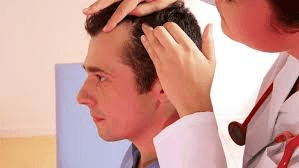Hair
What is androgenetic or androgenic alopecia?
What is androgenetic or androgenic alopecia (“male-pattern baldness,” “female-pattern baldness”)?
This type of alopecia is often attributed to genetic predisposition and family history. Androgenic alopecia is seen in both men and women. The hair loss in men is often faster, earlier onset, and more extensive.
Doctors refer to common baldness as “androgenetic alopecia” or “androgenic alopecia,” which implies that a combination of hormones and heredity (genetics) is needed to develop the condition. The exact cause of this pattern is unknown. (The male hormones involved are present in both men and women.)
Male-pattern baldness
Even men who never “go bald” thin out somewhat over the years. Unlike those with reversible telogen shedding, those with common male-pattern hair loss don’t notice much hair coming out; they just see that it’s not there anymore. Adolescent boys notice some receding near the temples as their hairlines change from the straight-across boys’ pattern to the more “M-shaped” pattern of adult men. This normal development does not mean they are losing hair.
Some “myths” about male-pattern baldness
- People inherit baldness through their mother’s male relatives. Actually, baldness is determined by genes from both the mother and the father. Looking at one’s family can give someone at best an educated guess about how he or she will turn out. Studies are ongoing in this field, and current research has been inconclusive about the inheritance patterns.
- Longer hair puts a strain on roots. It doesn’t. And hats don’t choke off the circulation to the scalp to cause hair loss either.
- Shampooing does not accelerate balding.
- “Poor circulation” does not cause hair loss, and massaging doesn’t stop it.








